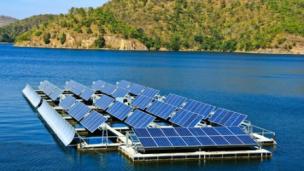
Activists against solar power often state ‘excessive land use/wastage’ as a reason not to support clean energy systems. Like most of their other reasons, we can prove this wrong when compared to other ‘dirty’ forms of energy – but now we can also install ‘floating’ solar power systems which don’t take up any land at all.
Singapore is going to be installing the nation’s first pilot floating solar power system. As an island nation, they have limited water and energy resources. They use a reverse osmosis water treatment system which can also have high energy costs involved in it and they also rely heavily on imported expensive electricity – therefore they have higher water prices as well as higher electricity prices.
The PUB, formerly known as the Public Utilities Board, plans to install a floating solar power system on the Tengeh Reservoir in combination with one installed on the Choa Chu Kang Waterworks. These two solar systems will provide for around 50% of the day time electricity needs for the water treatment plant (equipment, lighting and air conditioning) as well as for 1000 homes in the area. Work is expected to start in the middle of this month.
Minister for the Environment and Water Resources Doctor Vivian Balakrishnan said: “Desalination and water recycling through reverse osmosis have enhanced our water security considerably over the past decade. However, we are now even more dependent on energy for our water supply.”
The S$11 million Tengeh Reservoir project is led by the Economic Development Board, in partnership with the PUB, and managed by the Solar Energy Research Institute of Singapore. The project is set cover around 3 hectares and will sell clean energy back into the national power grid.
The PUB also expects to add to more floating solar power systems to waterworks over the coming years.
Not only do these solar systems not take up any land at all but they have their own set of advantages for the water they are installed on. They will aid in reducing costs associated with evaporation and algae build up.
The Indian state of Gujarat is also looking at expanding their floating solar systems. The state already has an operational 1MW canal-top system. They are now planning a 10MW system over the Sardar Sarovar Canal – the Government is pushing for the project to go ahead as it will not only provide power but it will save millions of litres of water from evaporation.
As a result of the numerous benefits in the power sector and the water sector of such systems, lenders like the World Bank are more likely to provide cheaper finance.
The Damodar Valley Corporation (DVC), also in India, is planning a 1000MW system over 2494kms of irrigation canals if finance help can be secured. Many other states are also looking to emulate such programs.
